Student Research —
Main Street Canandaigua Adapts to the Automobile: 1900-1930
Nathan Trombley, State University of New York College at Geneseo
Abstract
All American main streets faced the prospect of accommodating the needs of the motor vehicle as the twentieth century unfolded. Canandaigua, NY, the seat Ontario County with roughly 8,200 residents in 1900, was no exception. The passing of the horse-and-buggy era and growing evidence of ‘auto-adaptation’ are apparent from a series of five City Directories and three Sanborn Fire Insurance Maps between 1904 and 1930. A common assumption that the operators of horse-dependent enterprises were apt to pioneer automotive lines of business is largely not borne out by Canandaigua’s experience. Some premises, however, did cross both eras, and logical conversions occurred too, such as blacksmiths’ shops that switched to automotive repair. The transition was surprisingly late. The first vehicle-related businesses had appeared by 1914, a delay attributable perhaps to Canandaigua’s electric inter-urban link to Rochester. The last horse-related businesses had disappeared by 1924. By then, Main Street’s dozen auto-enterprises were relatively clustered along a two-block segment on the West side of the road. Later decades of the twentieth century would see a diaspora from Canandaigua’s Main Street core to its margins, and to US Highway 20 and NY Highway 332 strip development.
Introduction
Automobiles exploded onto the American landscape around the turn of the 20th century. This fast, personal, convenient, and increasingly cheap means of transportation spelled catastrophe for other modes of transport. Particularly, the horse industry suffered. The horse and wagon or carriage modality went from being the means of local transportation to near invisibility as the strength of the automobile industry and motor vehicle adoption both grew. The horse industry encompassed several component firms, all of which suffered as a result of the shift to automobiles. My paper focuses on Canandaigua, NY, a small city and county seat just shy of 30 miles from Rochester. An evocative testament to this dramatic transition comes from an early Canandaigua city historian, “in the 1880’s and 1890’s, before there were horse-drawn streetcars, or buses, or automobiles, only the horse and buggy and hacks furnished transportation. Instead of garages and gas stations there were blacksmith shops and livery stables and feed barns.” (Ellis, 1972.) Canandaigua was selected as a case study because it had and has an exceptionally strong Main Street by the more common standard of Main Street stagnation or decline, because it was and is relatively affluent, and because it was and is within the orbital influence of nearby Rochester.
State Context
To better understand its impacts, it is useful to frame the timing of the horse to automobile transition in Canandaigua to that of New York State as a whole. In general, New York (as well as most New England states) was an early adopter when it came to the automobile. In terms of number of vehicle registrations, New York ranked 5th among the states in 1900 and 1st in both 1905 and 1910. It is necessary, however, to normalize these data by the driving age population of each state. By that measure, New York ranked 12th among the states in 1910. (Flink, 1970.) It seems that New York adopted the automobile relatively early, although this ranking is likely skewed by the presence of New York City and the rest of the state likely exhibits a lower rate. By the end of the first decade of the 20th century there was one vehicle registration for every 100.4 driving age residents of the state (See Figure 2.)
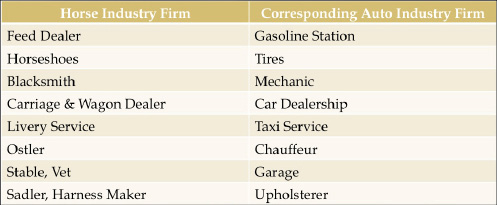
Figure 1. Horse industry businesses and their auto industry counterparts
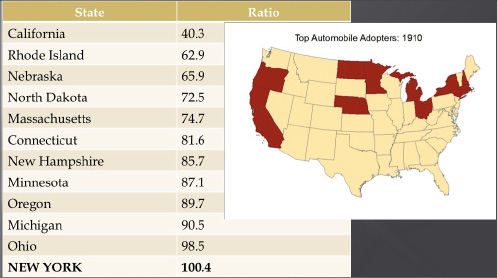
Figure 2. Leading automobile adapters in 1910 by adults per vehicle registration
Another factor that informs the transition to the automobile era in Canandaigua, but does not fit into this horse-to-auto industry study is the trolley service in the city. As stated at the onset, the advent of the automobile displaced multiple forms of transportation, not just the horse and carriage model. Canandaigua had a horse and mule-powered trolley system during the late 1800’s that travelled along Main Street. In 1894 the trolley was outfitted to use electricity, and a few years later, the trolley became part of a larger interurban network. The Canandaigua branch suffered declining ridership over the years and was suspended in 1930 (Paulson, 2013.) This phase of diminishing demand corresponds to the most vigorous period of Main Street Canandaigua’s automobile adaptation, which occurred between 1914-1924. In general, the personal automobiles afforded much greater speed (and eventually comfort) than the horse-drawn buggy, and far greater flexibility of movement than the trolley.
Analyses
In this paper I will address the following questions: What changes in Main Street businesses in Canandaigua represented a shift to the automobile era? Did new automobile-related businesses appear in the same location as horse-related predecessors or did they spring up elsewhere? Did new businesses have the same owners or not? Identifying shifts from the left to right column of Figure 1 will suggest the framework and timing of the transition. In general, there are two possibilities. The first is an evolution of the horse industry into its automobile counterpart, which would entail auto businesses replacing their horse counterparts in the same locations and with the same owners, suggesting a retrofitting of the horse industry and seamless adaptation to the automobile. The other possibility is a replacement of the horse industry by the automobile industry, characterized by businesses in new locations with new owners, suggesting that there was little reuse and that the horse industry merely dropped away as the automobile industry moved in.
Study Area
Canandaigua, NY, is the seat Ontario County and had approximately 8,200 residents in 1900 and lies within Rochester’s area of influence. Canandaigua’s Main Street remains vibrant in spite of external influences, such as suburban strip-mall development. Data were collected on a transect along Main Street south from West Ave. to Routes 5&20 (See Figure 3) which covers approximately 1.2 kilometers (or 0.75 miles). This stretch is significant not only as a popular main street setting, but also because it is an old part of Route 20, a transcontinental Federal Highway. As a main arterial across the country it brought a considerable amount of traffic into Canandaigua during this transitional era and is a prime candidate for study.
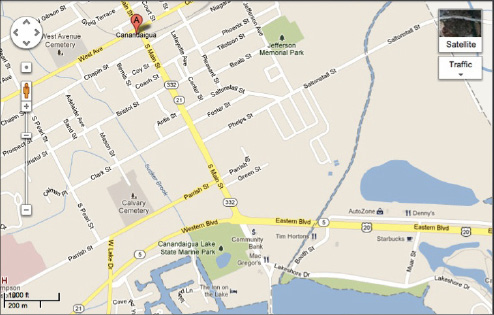
Figure 3. Map of the study area, Main Street Canandaigua (Route 332) from West Ave. to Routes 5&20
Methods
Data for the study were collected along the transect from both the field and from primary source. These primary sources were the Canandaigua city directories obtained from the Ontario County Historical Society and Sanborn Fire Insurance Maps obtained from the Ontario County Department of Records, Archives, and Information Management Services. Walking and sketching Main Street buildings supplemented this information. Horse-related businesses were recorded along with their addresses and owners. The same was done for automobile-related businesses. Data were taken for five years (1904, 1911, 1914, 1924, and 1930) and mapped for analysis.
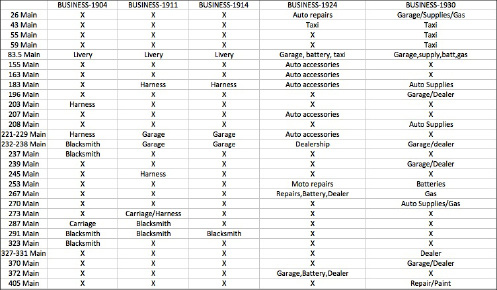
Figure 4. First data table, business type by address and year. See a larger view of this image.
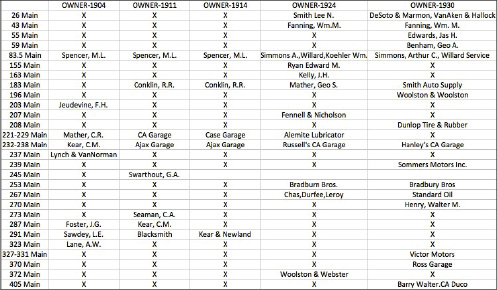
Figure 5. Second data table, business owner by address and year. See a larger view of this image.
Results
The data collected for this study is presented as Figures 4 and 5. The maps for 1904, 1914, and 1924 are also included as Figures 6, 7, and 8, respectively. The dramatic shift in the transportation industry occurred during the second decade of the twentieth century. In the 1904 sample, only horse related businesses appear along the transect, but in the 1911 and 1914 samples, horse and auto related businesses coexist (with horse service industries being the majority.) By the 1924 sample, however, only auto businesses appear and the transition was complete. Indeed, this foundational transition in the transportation industry occurred quite quickly in Canandaigua, going from one extreme to the other in only about a decade.
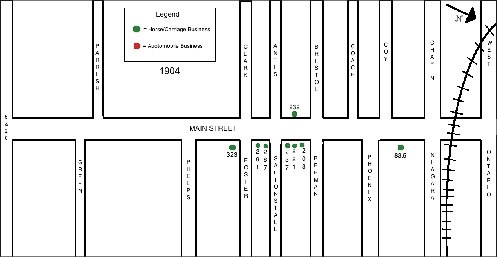
Figure 6. Map of business location and type-1904. See a larger view of this image.
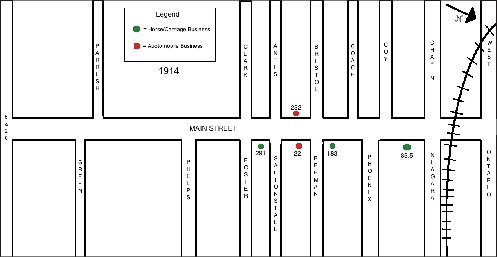
Figure 7. Map of business location and type-1914. See a larger view of this image.
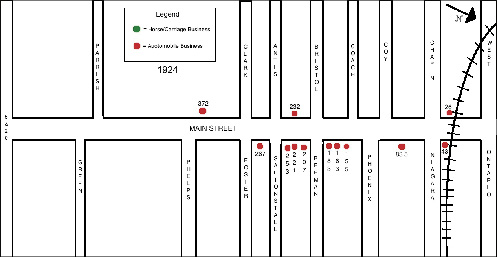
Figure 8. Map of business location and type-1924. See a larger view of this image.
Were the buildings designed for the car or did the car adapt to existing buildings? A clear pattern does not emerge. As an example, consider 253 South Main St. The Sanborn maps reveal that in 1904 this structure was a parsonage with a horse stable. By 1911 it was being used as an undertaker’s and in 1924 had become a gasoline station, in each instance the same building was repurposed. The opposite can be seen at 372 South Main St., which underwent significant structural changes between 1911 and 1924, when its use switched from a foundry to an auto garage. Of the 11 lots used for horse related businesses in the period studied, four were repurposed as auto service businesses and seven were not, evidently not desirable for the new demands of the industry. Additionally, the lack of automobile dealerships may be related to the relatively large number in nearby Rochester.
Did related auto businesses replace horse ones or were the new services offered different? In most cases they did, with the prime example being blacksmith shops transitioning to automobile garages (consider the example of 232 South Main St.) Seventy-five percent of the lots that were used for both horse and auto businesses saw these “logical” transitions as laid out in Figure 1 (e.g. livery to taxi, harness to auto accessories, blacksmith to garage.)
Was there continuity in business ownership across the transition or did replacement occur? The common assumption that ownership continued is largely not borne out in this case study. Consider 83 ½ South Main St. M.L. Spencer was the longstanding owner of a livery at this location that appeared in 1904, 1911, and 1914. When the location became an auto garage by 1924, however, Mr. Spencer was no longer associated with the business. Born in 1842, Spencer was simply too old to transform his business with the changing industry and none of his three children elected to take up the reins (Ellis, 1972.) Instead of transitioning with his business into the new era, he simply left the Main Street business scene. The advertisements presented in Figure 9 illuminate this example.
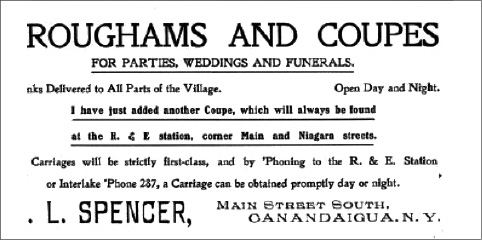

Figure 9. Advertisement for 83½ Main St. in 1904 (top) and 1924 (bottom)
Discussion
Canandaigua made a rapid transition to the automobile between 1914 and 1924. This was slightly behind the average for New York State. Determining whether the transition followed the evolution or replacement model described above is not so straightforward. Most of the locations from 1904 were still in use in 1914, and most of these had transitioned to automobile-related businesses. At the same time, most of the locations that were in use both in 1904 and 1914 had new owners at the latter date. For the next period, 1914 to 1924, most of the locations from 1914 were still in use in 1924, but they were all under new ownership, and many more locations had come into use. Between these years, logical transitions occurred, with a harness shop turning into an accessory shop and a livery service turning into a taxi service. It is difficult to classify the transition in Canandaigua as evolutionary or replacement. The frequent changes in ownership certainly suggest a replacement model. In terms of continuity of location, most were reused from one period to the next, yet the significant drop in total businesses from 1904 to 1914 and the multitude of new locations from 1914 to 1924 suggest that reusing space was not sufficient for the new industry, excess horse-related business had to be shed as demand for them fell between 1904 and 1914 and new businesses had to emerge in addition to reusing space as the demand in the auto industry rapidly grew. Perhaps the best conclusion is that Canandaigua adopted an evolutionary transition to the extent it was possible, but the inherent differences in the two industries necessitated replacement-like trends in several areas.
Summary
Today most of the automobile industry has clustered in the commercial strips located on NY 332 and US 5&20. There are, however, two remaining vestiges of this transitional era on Main Street. My father, who took over the business from his father who founded it in 1960, owns one of them. The site is one that first appeared as an auto garage in the 1924 sample. This dramatic revolution in transportation occurred throughout the United States and looking at it through the lens of studies like this can shed light on the present. Did Canandaiguans notice a transition was happening? Will we know when another such change is taking place? Is it already happening and if so, what are we moving towards, renewed interest in public transportation and biking, new types of automobiles with alternative fuel sources? If another transportation revolution is occurring, where are we in it? Looking to the past can help us better understand these questions.
References
Canandaigua City Directories, Ontario County Historical Society.
Ellis, Herbert J. “Slower Pace in Horse, Buggy Days.” The Daily Messenger. 28 April 1972: Page 29.
Flink, James J. America Adopts the Automobile, 1895-1910. Cambridge: The MIT Press, 1970.
Paulson, Lynn. “Taking the Trolley.” The Daily Messenger. 14 April 2013: C1+C2.
Sanborn Fire Insurance Maps, Ontario Country Department of Records, Archives, and Information Management Services.
Contributor Biography
Nathan Trombley is a resident of Canandaigua, NY. He is graduate of SUNY Geneseo in Geneseo, NY with a BA in Geography as well as academic minors in Geological Sciences and Economics. He is planning on attending graduate school in the fall of 2014 pending admissions decisions.
Return to top

